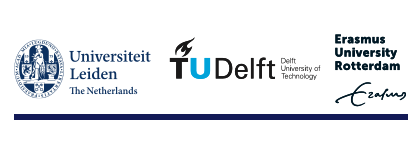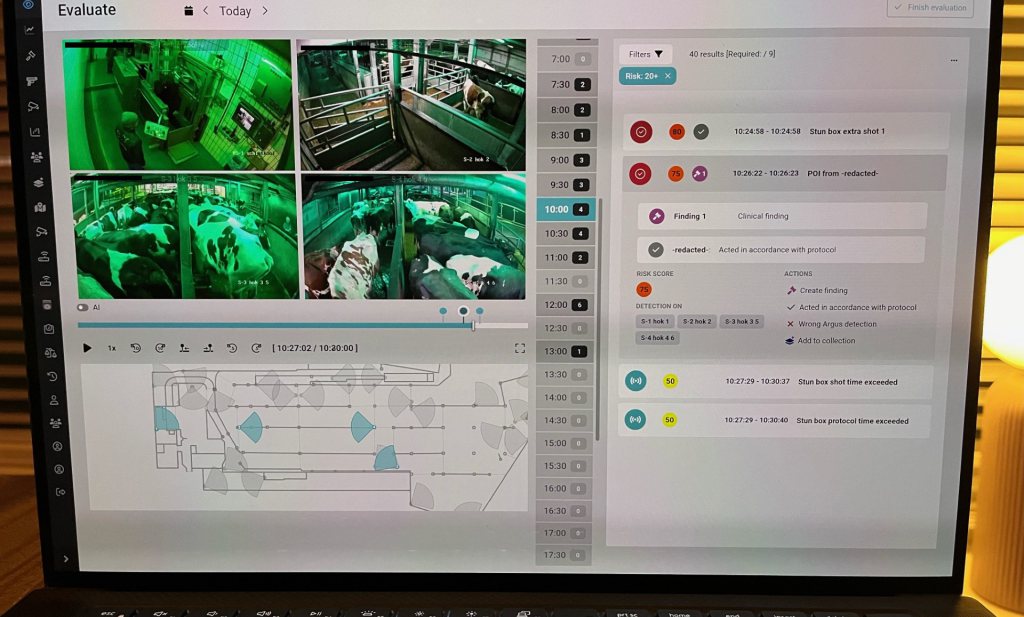In July 2021, slaughterer Gosschalk in Epe received a heads-up from RTL News. The channel would run a story with undercover footage taken at the slaughterhouse. Shortly thereafter, the Dutch Food and Consumer Product Safety Authority (NVWA) shut down the slaughterhouse because of the filmed abuses. All the more reason for Gosschalk to accelerate an already existing initiative. Cornerstones of the action plan to reopen the slaughterhouse were appointing an animal welfare supervisor and installing an AI-driven camera surveillance system.
During the Digital Food webinar on November 29, 2022, Roy Melsert and the founders of the AI company Argus recounted how they are using AI to rebuild trust with the public and regulator after the scandal that almost cost Gosschalk its slaughter license.
Can you restore trust after your slaughterhouse has been publicly shamed based on undercover footage? A surprising 96% of participants in the Digital Food webinar say 'yes.' The key is to communicate openly and transparently and rebuild trust. Without trust, there is no business. And that's what Gosschalk tried to focus on.
Measuring and improving
Gosschalk is a family business where the fifth generation is now at the helm. The company slaughters pigs and cattle and can slaughter 600 and 130 animals per hour respectively. After the broadcast by Dutch broadcaster RTL News, the company was shut down by order of the NVWA (the Dutch food and commodities authority). It remained closed for nine weeks because Gosschalk wanted assurance that the abuses could not recur.
That means speed is no longer the most important criterion; animal welfare comes first. To prove that incidents are not systematic, you have to measure, as said by famous animal welfare expert Temple Grandin. Only if you measure can you improve. Gosschalk took drastic measures. The slaughterhouse appointed Roy Melsert as animal welfare supervisor. He gained his knowledge from Temple Grandin, from the Humane Slaughter Association, University of Bristol, and above all learned a lot in 26 years of practice. In addition, Gosschalk installed a new camera surveillance system developed by the startup Argus. Every three months, the NGO ‘Eyes on Animals’ comes by for an inspection. However, their inspection should not be seen as certification, the organization says. That responsibility rests with controlling agencies.
Argus is a new company founded by Louis Gosschalk (related but not involved in the slaughterhouse) and Niels Ilmer. When things seemed to go wrong at Gosschalk, a primitive version of Argus was already available, but the closure provided the perfect opportunity to accelerate the market launch of Argus. The underlying idea: guarantee animal welfare through artificial intelligence and real-time observation through sensors on the tools used.
'Risk score'
Camera surveillance is actually nothing new. But in traditional applications, everything is recorded and an inspector must randomly plow through an infinite number of hours of material to find an incident. That doesn't work and certainly not with the understaffed NVWA.
Argus offers an overview of all risk moments on a silver platter, so the inspector only has to look at them.
The basis of the system is the "risk score," based on measurements and observations. Per location, camera and time moment are used to determine what the risk score is, which means that the person viewing the camera images can zoom in on the situations where there is a real risk of things going wrong.
In addition, there are all kinds of sensors and the person viewing the images can use "clickers" to mark a situation that needs to be looked at more closely. Melsert can also do that at any place and any time during the slaughter process, if he sees something happening 'live' that deserves further analysis. A quick 'click' of the button that he carries with him and the system signals the moment for later review.
The underlying AI helps determine where the risk increases, such as when there is human-animal interaction, when devices are used to correct an animal, and when an animal exhibits unexpected behavior, such as remaining behind.
"Working with Argus is 'a dream come true,'" Melsert says straightforwardly. "You can really be transparent now, and that's totally in line with the trend of more transparency throughout the industry." Being able to show that there are incidents and not structural abuses should help rebuild trust in Gosschalk.
Argus is not the only system to make transparent what happens in slaughterhouses, and slaughterhouses are not the only place to track animal welfare. For example, AI cameras could also play a role in a European consortium working on aggression in stalls and tail-biting, says webinar participant Isa Kernberger-Fischer of Germany's Friederich Loeffler Institut, which works on pig welfare, among other things. Because there is no data on the routine docking of tails, the European ban on it cannot be enforced.
Multi-stakeholder approach
Webinar participants unequivocally agreed that a multi-stakeholder approach is the way forward. Sharing data, learning experiences, and connecting with each other creates a network that benefits all parties. Slaughterhouses will have to be transparent and share best practices. NGOs, both animal welfare organizations and animal activists, can implement data-driven transparency to be objectively distinctive and reliable. For example, the Dutch Society for the Protection of Animals (Dierenbescherming) is considering integrating AI-supported camera surveillance into the Better Life label (Beter Leven-keurmerk).
And the consumer? The consumer wants to know what he or she is paying for when buying meat that comes from guaranteed well-slaughtered animals. Whoever wants that to be true must show that there is nothing more to hide.
Can you restore trust after your slaughterhouse has been publicly shamed based on undercover footage? A surprising 96% of participants in the Digital Food webinar say 'yes.' The key is to communicate openly and transparently and rebuild trust. Without trust, there is no business. And that's what Gosschalk tried to focus on.
Measuring and improving
Gosschalk is a family business where the fifth generation is now at the helm. The company slaughters pigs and cattle and can slaughter 600 and 130 animals per hour respectively. After the broadcast by Dutch broadcaster RTL News, the company was shut down by order of the NVWA (the Dutch food and commodities authority). It remained closed for nine weeks because Gosschalk wanted assurance that the abuses could not recur.
That means speed is no longer the most important criterion; animal welfare comes first. To prove that incidents are not systematic, you have to measure, as said by famous animal welfare expert Temple Grandin. Only if you measure can you improve. Gosschalk took drastic measures. The slaughterhouse appointed Roy Melsert as animal welfare supervisor. He gained his knowledge from Temple Grandin, from the Humane Slaughter Association, University of Bristol, and above all learned a lot in 26 years of practice. In addition, Gosschalk installed a new camera surveillance system developed by the startup Argus. Every three months, the NGO ‘Eyes on Animals’ comes by for an inspection. However, their inspection should not be seen as certification, the organization says. That responsibility rests with controlling agencies.
Camera surveillance is actually nothing new. But in traditional applications, everything is recorded and an inspector must randomly plow through an infinite number of hours of material to find an incidentArtificial Intelligence and real-time observation
Argus is a new company founded by Louis Gosschalk (related but not involved in the slaughterhouse) and Niels Ilmer. When things seemed to go wrong at Gosschalk, a primitive version of Argus was already available, but the closure provided the perfect opportunity to accelerate the market launch of Argus. The underlying idea: guarantee animal welfare through artificial intelligence and real-time observation through sensors on the tools used.
'Risk score'
Camera surveillance is actually nothing new. But in traditional applications, everything is recorded and an inspector must randomly plow through an infinite number of hours of material to find an incident. That doesn't work and certainly not with the understaffed NVWA.
Argus offers an overview of all risk moments on a silver platter, so the inspector only has to look at them.
The basis of the system is the "risk score," based on measurements and observations. Per location, camera and time moment are used to determine what the risk score is, which means that the person viewing the camera images can zoom in on the situations where there is a real risk of things going wrong.
In addition, there are all kinds of sensors and the person viewing the images can use "clickers" to mark a situation that needs to be looked at more closely. Melsert can also do that at any place and any time during the slaughter process, if he sees something happening 'live' that deserves further analysis. A quick 'click' of the button that he carries with him and the system signals the moment for later review.
The underlying AI helps determine where the risk increases, such as when there is human-animal interaction, when devices are used to correct an animal, and when an animal exhibits unexpected behavior, such as remaining behind.
"Working with Argus is 'a dream come true,'" Melsert says straightforwardly. "You can really be transparent now, and that's totally in line with the trend of more transparency throughout the industry." Being able to show that there are incidents and not structural abuses should help rebuild trust in Gosschalk.
Argus provides an overview of all risk moments on a silver platter, so the inspector only has to look at thoseMore applications
Argus is not the only system to make transparent what happens in slaughterhouses, and slaughterhouses are not the only place to track animal welfare. For example, AI cameras could also play a role in a European consortium working on aggression in stalls and tail-biting, says webinar participant Isa Kernberger-Fischer of Germany's Friederich Loeffler Institut, which works on pig welfare, among other things. Because there is no data on the routine docking of tails, the European ban on it cannot be enforced.
Multi-stakeholder approach
Webinar participants unequivocally agreed that a multi-stakeholder approach is the way forward. Sharing data, learning experiences, and connecting with each other creates a network that benefits all parties. Slaughterhouses will have to be transparent and share best practices. NGOs, both animal welfare organizations and animal activists, can implement data-driven transparency to be objectively distinctive and reliable. For example, the Dutch Society for the Protection of Animals (Dierenbescherming) is considering integrating AI-supported camera surveillance into the Better Life label (Beter Leven-keurmerk).
Consumers must be shown that there is nothing left to hideThe NVWA, the Dutch supervisor, is also positive about AI in the slaughterhouse. A system like Argus not only saves an enormous amount of capacity in supervision, but also offers concrete starting points to actively implement improvements. Nathalia Japas Gussenhoven, inspector for live animals of the NVWA, thinks the way Gosschalk has responded to the embarrassing situation that has arisen is "very good." By acting together, the regulator can intervene more quickly and then ensure that companies take responsibility and make measurable improvements.
And the consumer? The consumer wants to know what he or she is paying for when buying meat that comes from guaranteed well-slaughtered animals. Whoever wants that to be true must show that there is nothing more to hide.
Related



